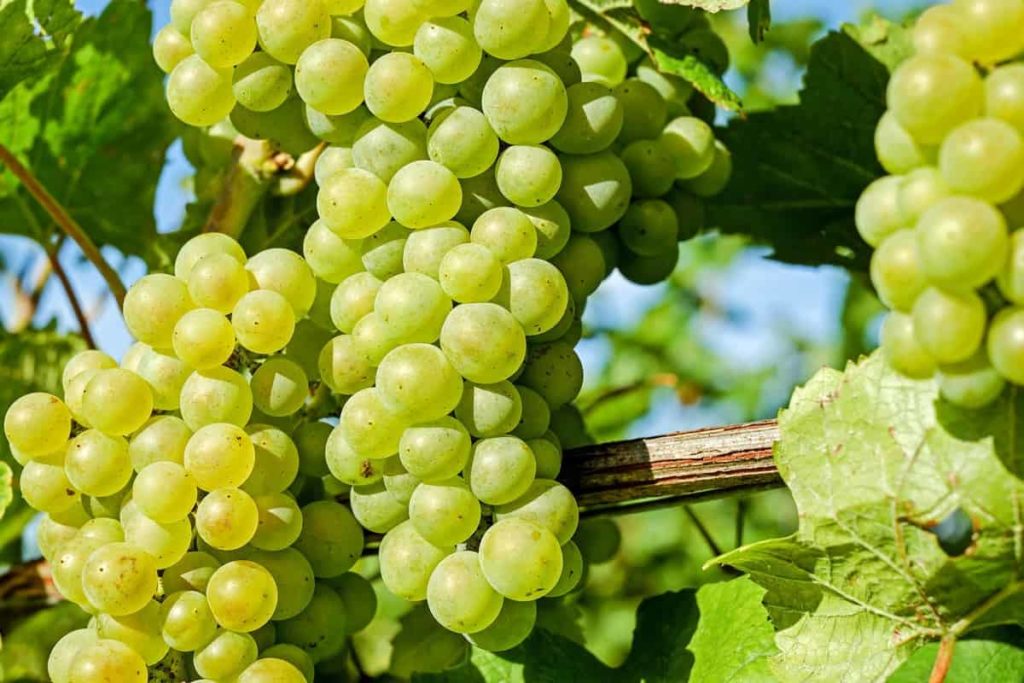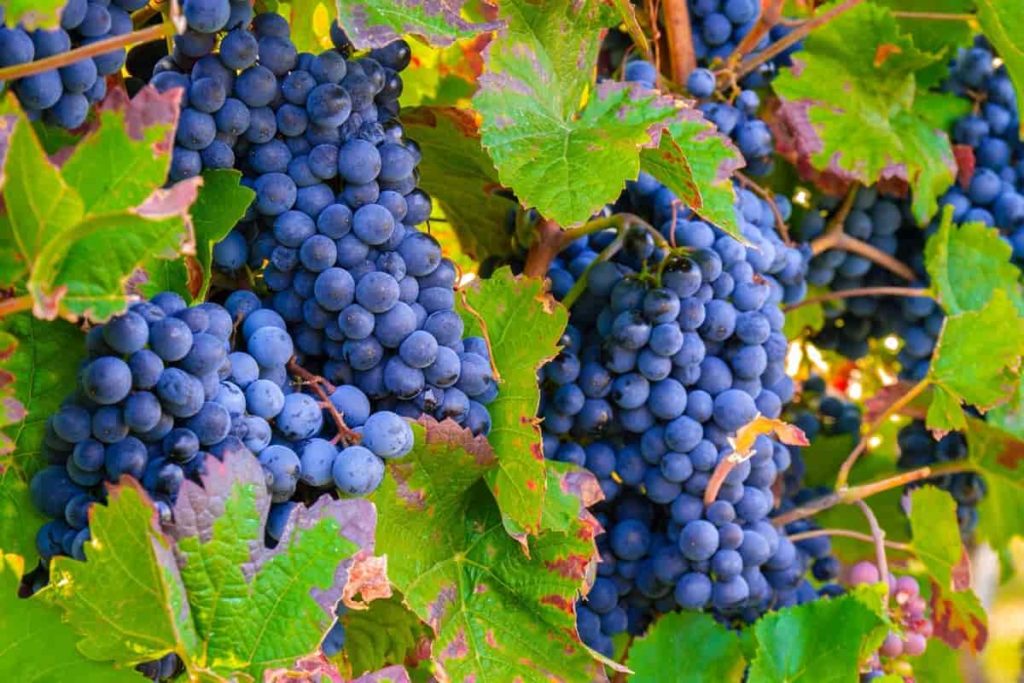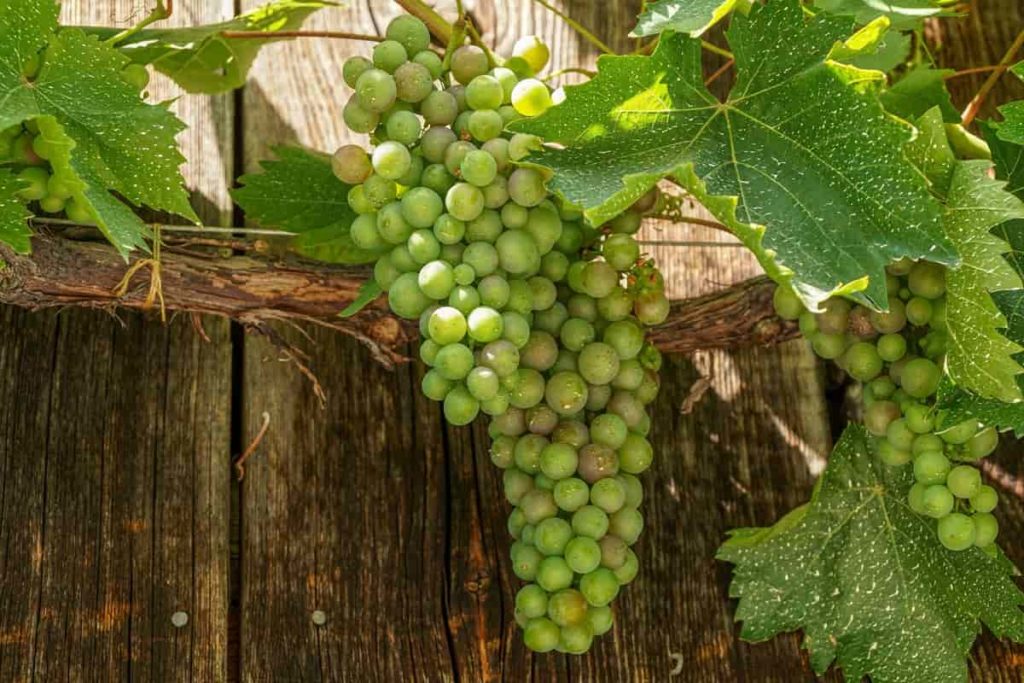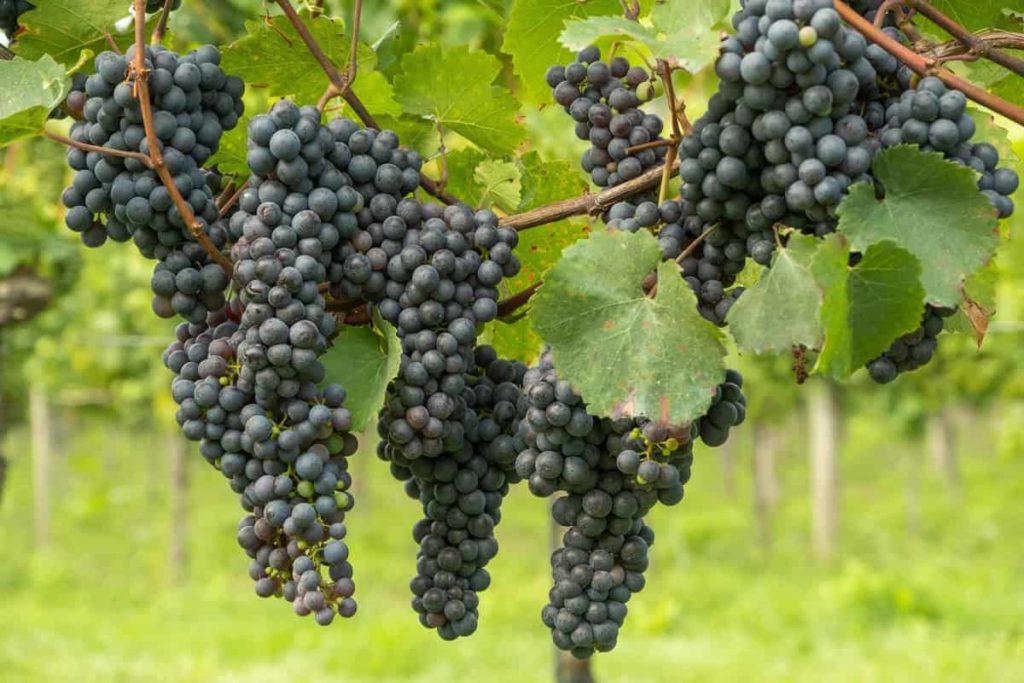Different types of nutrients should be applied to Grapes in the growing season. Fertilizing Grapes can increase annual production, increase the quality of Grapes and wine quality, and improve soil properties. Grapes are generally not a heavy feeder and do not require much fertilizer after they are well established. Too much fertilizer can stimulate the growth of wood and leaves rather than fruit production.

Moderate quantities of fertilizer during the first and second years after planting will help young plants size for earlier fruit production. Grapes require macronutrients, including phosphorus, nitrogen, and potassium. Grapevines also need micronutrients like copper, zinc, and iron. Offering the most beneficial nutrients and soil needs ensures healthy plants that achieve their maximum potential. So, you should choose a fertilizer that meets your Grapes requirement. Let’s check out the best fertilizer for Grapes.
Nitrogen – Grapevines have relatively low nitrogen requirements compared to many other crops. Although nitrogen fertilization can increase Grape quality and production, it cannot do so if applied at the wrong time or more. Therefore, it is important to find out whether the Grapevines are likely to benefit from nitrogen supplements and if so, apply proper time and quantity of nitrogen.
Phosphorus – Phosphorus is always needed, as it plays an important role in the transportation of nutrients. Furthermore, during the first years after planting, phosphorus helps the plant develop a healthy root system.
Potassium – Potassium plays a key role in fruit sets and fruit quality. If your soil has enough nutrients, the acidity level of Grapes is balanced and fruit production increases.
Magnesium – Proper magnesium in the soil allows vines to produce dark green leaves and stems. Without an adequate amount of chlorophyll in leaves and vines to provide proper protection from the elements, the Grapes themselves cannot ripen properly.
Zinc – Test your soil for the proper level of zinc before planting a Grapevine. Zinc improves Grape production and contributes to the proper formation of individual Grape and Grape cluster sizes.
In case you miss this: Grapes Gardening For Beginners – How To Start, FAQs

Best fertilizer for Grapes
Homemade fertilizers for Grapes
Banana peels
Banana peels contain basic nutrients for plants. After they are decomposed, they provide adequate amounts of potassium as well as magnesium, nitrogen, and phosphorus. The best part of banana peel is that it acts as a slow-release fertilizer. So, of course, banana peels are good for Grapes.
Epsom salt
If the soil is deficient in magnesium, Epsom salt can be beneficial for Grapevine. But using only the mixture as a common fertilizer can cause problems for your Grapes.
Coffee Grounds
Coffee grounds organic matter involved in the soil helps in water conservation and acts as nitrogen-rich fertilizer for vines, which encourages growth. The use of coffee grounds for Grapevines also reduces waste if the areas were to be dumped in the garbage.
Lime
Replacing the dolomitic lime in the soil above the roots of the Grape can help to increase the pH if it is too low.
Wood ash
Grapes are sensitive to soil acidity. Our soil is a little acid for Grapes to thrive. Apply wood ash on the planting soil and lift it from pH 6.0 to 6.5 levels till it is put in the connecting soil to neutralize the pH.
In case you miss this: Growing Grapefruit In Backyard Of Home Garden

Compost manure for Grapes
Compost
The most effective fertilizer for use for Grapevines is aged compost. Compost consists of dissolved organic matter such as Grape pomace, yard clippings, and manure.
Manure
Apply 5 to 10 pounds of chicken or rabbit manure or 5 to 20 pounds of a steer or cow manure per Grapevine. Chicken manure is a beneficial soil supplement. It incorporates organic stuff and enhances water retention capabilities. In addition, chicken manure provides phosphorus, nitrogen, and potassium to your plants (more than running cows, horses, or fertilizers). So, you can add chicken manure to the Grapes. But don’t add too much. Too much chicken manure makes plants bushy without fruits.
Organic fertilizers for Grapes
Bone meal
The bone meal is a good organic source of phosphorus, for new Grapevines, mix a teaspoon of bone meal in the planting hole.
Cottonseed meal
In areas that have low nitrogen, the vines mostly respond to feeding this element on a set of fruits. This is the period in which the vines draw the heaviest nitrogen in the soil to form clusters of Grapes. Good sources of nitrogen include blood meals and cottonseed meals.
Natural fertilizers for Grapes
Greensand
If the soil is depleted, add potassium modification when the vines flower. Sul-Po-Mag is a good source of potassium, as are ground greens and or granite meal.
Mulch
A 2-inch surface of pine straw or chopped wooden mulch around the vine. As soon as these mulches decompose add organic matter to the soil which your Grapevines will like. Avoid using fresh sawdust or wood chips until they are fixed in the pile for at least 6 months.
Liquid fertilizers for Grapes
Compost tea
Drenching with compost tea is a great way to rapidly transport organic fertilizers and beneficial organisms from fertilizer to plant root zone. Just pour a mixture of tea on the soil in the area below the leaves of the Grape plant.
In case you miss this: Growing Grapes in Pots from Seed and Cuttings

Commercial fertilizers for Grapes
NPK ratio
A 10-10-10 Fertilizer is a great choice for Grapevines, as it provides equal amounts of nitrogen, phosphorus, and potassium. In 10-10-10 fertilizer, three important ingredients offer special functions for Grapevines. Nitrogen is crucial for fruit growth and improves leaf quality so that Grapevines can better convert sunlight into nutrients. Phosphorus helps the roots to deepen and strengthen, and it ensures that Grapes will prepare enough sugars to be sweet and juicy when ripe.
Potassium works to make a healthy vine, it helps in resistance to disease. It also helps the vine grow high-quality Grapes. Other nitrogen fertilizers such as urea, ammonium nitrate, and ammonium sulfate should be applied after bloom or when the Grape reaches 1/4 inches in diameter.
Grape fertilizer schedule
All Grape clusters have the same phosphorus and potassium requirements. American varieties may need high amounts of nitrogen to perform well, but there is a significant difference in soil pH priorities. American Grape varieties require acidic soil, with an ideal pH of 5.5. They require relatively high iron and increase iron solubility in acidic conditions. European vinifera varieties prefer soil pH to be around 6.5. Once established, the Grapevine can be productive for 40 years or more. Proper soil preparation before planting will help in the formation of successful vines.
Add limestone at the recommended rate on soil test results 6 months to one year before planting. Liming is not recommended for American varieties up to a pH of 5.5 or for European varieties up to 6.5. Use a dolomitic limestone if soil testing magnesium values are as low as possible and pH needs to be increased. In conditions where soil pH levels are maximum but soil magnesium levels are as low as possible, add 1 pound of Epsom salt per 100 square feet. Re-examine the soil every 3 years to monitor the pH level.
If a soil test reveals phosphorus is as low as much, apply triple phosphate at a rate of 226 grams, superphosphate at a rate of 566 grams, or bone meal at a rate of 1 kg per 100 square feet. If soil testing potassium is as low as possible, add potassium sulfate at the rate of 340 grams or 4.5 kg of greensand. Add all necessary amendments at a depth of 6 to 8 inches.
If soil testing is maximum of potassium and phosphorus, apply only a source of nitrogen on the vines. Urea will provide the required amount of nitrogen at 56 to 85 grams, ammonium nitrate at 85 to 175 grams, or 226 grams of blood meal per vine. Excessive vegetative growth indicates the need to reduce nitrogen intake by one-half or to release completely for one to two years.
In case you miss this: Top 10 Tips to Protect Plants from Frost: Ideas and Techniques for Beginners

1st year – Apply 113 grams of 10‐10‐10 per vine immediately after growth starts, and repeat about 4 weeks later. 4 to 5 feet will spread evenly over the diameter area.
2nd year– Apply 226 grams of 10‐10‐10 per vine immediately after growth starts, and then about 4 weeks later. 4 to 5 feet will spread evenly over the diameter area.
3rd year and older– Apply 226 grams of 10‐10‐10 per European Grapevine, 453 grams for American Grapevine at bud break. Spread evenly 3 to 5 feet wide on each side of the Grapevine.
Once every 3 years, the borax application can be beneficial. Borax should not apply more than 22 grams per 100 square feet. Excess boron can cause plant injury. Borax can be dissolved in water and sprayed on the ground. To prevent damage to the sprayer, strain the sediment after the borax is dissolved.
How to fertilize Grapes in pots
Grapes are amazing plants, they grow very easily even without much maintenance, but it is always good to feed them a little fertilizer around spring to help them produce new canes, and also help them grow delicious Grapes during their fruit season height. Side dress plant with aged manure or compost from time to time. In the first year, you can fertilize the Grape plant with a general-purpose fertilizer in spring and summer.
From the next year start fertilizing the plant with low nitrogen content but more potassium and phosphorus from spring when flower buds appear. Never use too much fertilizer if you want to produce crops, but if you are growing Grapes for decoration purposes you can use 10-10-10 or 15-15-15 fertilizers. You can top-dress your plants up to the top of the same layers of mature compost manure or standard fertilizer by removing a few inches of topsoil or compost.
Frequently asked questions about fertilizers for Grapes (FAQ)
Is Miracle-Gro good for Grapes?
Miracle-Gro is a popular brand among gardeners. They produce a lot of organic and inorganic fertilizers. You can choose Miracle-Gro fruit fertilizer for your Grapes.
Why are my Grape leaves turning brown and yellow?
Iron deficiency is the most common culprit that causes leaf tissues to turn yellow, only veins remain green. Potassium deficient in Grapevines is similar to those that are deficient in iron, except that the address will eventually dry up and die.
In case you miss this: Guide to Growing Tomatoes in Florida: In Winter, Summer, in Backyard and Containers

Can you use tomato feed on Grapevines?
Feed dessert Grapes every two weeks with high potassium fertilizer like tomato feed, from one month after the spring growth begins to start ripening.
Why are my Grapes so small?
There are some causes of Grapes that cause small Grapes. So, they include young plants that are not able to help with growth and do not provide enough water throughout the fruit maturity period. In addition, high fertilization, temperature, stress, and insects can cause small Grapes.
Why wouldn’t my Grapes produce fruit?
If you have given too much nitrogen fertilizer to your Grapevine, it can result in green growth of leaves and no fruit. Even if there is too much nitrogen in the soil, it happens. If you believe this is the reason why you don’t have Grapes on your vines, do things differently next year.
Why are my Grape leaves curling?
Lack of nutrients can also cause Grape leaves to become a cause of curling. If the soil in which the Grapevine is planted is deficient in potassium and phosphorus, the leaves may start curling. Soil modification can solve this problem and restore the health of Grapevines.
Is gypsum good for Grapes?
Gypsum is a source of calcium and sulfur for Grapevines. However, the release of these nutrients from gypsum is slower than the most soluble liquid fertilizers.
- Growing Gold: Essential Techniques for Planting Pineapples
- How to Make Kalanchoe Plant Bushy: Home Remedies and Solutions
- 11 Reasons Why Your Gardenia is Not Blooming: Home Remedies and Solutions
- Eco Elegance: The Guide to Designing a Drought-Tolerant Landscape
- Gardening on a Slope: Strategies for Hillside Landscaping
- Nourish and Flourish: Top Organic Mulches for Thriving House Plants
- Everything You Want to Know about Indian Mogra Flower: Discover Uses and Growing
- Green Thumb Success: Expert Tips for Cultivating Greenhouse Pumpkins All Year Round
- Maximize Growth & Flavor: The Ultimate Guide to Companion Planting in Herb Gardens
- How to Control Rhododendron Problems Naturally: Home Remedies and Organic Ways to Fix Them
- Natural Magic: The Remarkable Benefits of Cinnamon for Plants
- Best Steps to Revive Dying Tulip with Natural and Organic Treatment
- 10 Reasons Why Your Angel Trumpet is Not Blooming: Remedies and Treatment
- How to Fix Periwinkle Leaf and Flower-Related Problems: Natural Remedies and Solutions
- How to Fix Zinnias Leaf and Flower Problems: Discover Natural and Home Remedies
- Organic Steps to Induce Lemon Tree Flowers: A Comprehensive Guide
- Bloom Booster: Crafting the Perfect Homemade Bougainvillea Fertilizer
- Optimizing Growth: A Guide to Applying NPK Fertilizer for Potted Plants
- 10 Best Homemade Fertilizers for Rubber Plant: DIY Recipes and Application Method
- How to Boost Female Pumpkin Flowers: Effective Steps for More Flowers and High Yields
- Transform Your Indoor Garden: Top Benefits of Pink Salt for Houseplants
- 10 Best Homemade Fertilizers for Peacock Plants (Calathea): Easy DIY Guide
- Unlock Blooms: 9 Reasons Why Your Potted Chrysanthemum is Not Blooming
- 8 Reasons Why Your Potted Hibiscus is Not Blooming: Fix it with Simple Solutions
- Unlock Blooms: 9 Key Reasons Your Potted Frangipani Won’t Flower
- 10 Reasons Why Is My Ice Plant Not Blooming: Remedies and Treatment
- 10 Reasons Why My Potted Hydrangea Not Blooming: Treatment and Remedies
- 10 Reasons Why is My Wisteria Not Blooming: Remedies and Treatment
- 10 Reasons Why is My Goldfish Plant Not Blooming: Remedies and Treatment
- Maximize Your Space: Ultimate Guide to Balcony Gardening with Grow Bags
- 10 Reasons Why Your Iris is Not Blooming: Remedies and Treatment
- 10 Reasons Why Your Anthurium Plant is Not Blooming: Treatment and Remedies
- 10 Reasons Why Your Aquaponic Plants Are Not Flowering: Remedies and Treatment
- 10 Reasons Why Your Agapanthus is Not Flowering: Remedies and Treatment
- Ultimate Guide to Brown Turkey Fig: Steps to Growing Brown Turkey Figs
- How to Grow Acai Berry: Propagation, Planting, and Care
In my opinion it is good treasure of knowledge and provides information which is of great value.However it will be more impressive if presented pointwise and briefly. Appreciate your efforts.